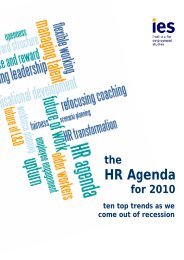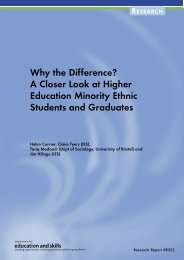Post-16 Transitions: a Longitudinal Study of Young People with ...
Post-16 Transitions: a Longitudinal Study of Young People with ...
Post-16 Transitions: a Longitudinal Study of Young People with ...
Create successful ePaper yourself
Turn your PDF publications into a flip-book with our unique Google optimized e-Paper software.
Table 4.15: Most helpful person when preparing for post-<strong>16</strong> activities<br />
All<br />
Statemented<br />
Non-statemented<br />
Special<br />
school<br />
Mainstream<br />
school<br />
N = % % % % %<br />
Parents/carers 741 45 39 50 33 48<br />
Other school staff 295 <strong>16</strong> 20 12 29 12<br />
School Careers Adviser 277 <strong>16</strong> <strong>16</strong> 15 18 15<br />
Careers Service/ Connexions<br />
personal adviser<br />
142 7 9 6 8 7<br />
SENCO 122 6 9 5 5 6<br />
Friends or partner 62 4 3 5 1 5<br />
Other family member 45 3 1 5 1 4<br />
Social Worker/Services 25 1 2 1 3 1<br />
Doctor/health worker 5 * * 0 1 0<br />
Other 26 1 1 1 1 2<br />
Note: All percentages are weighted percentages, unless otherwise stated<br />
* - less than 0.5 per cent<br />
Source: IES/MORI 2003<br />
planning for the transition than those <strong>with</strong>out statements and<br />
those in mainstream schools.<br />
Just seven per cent <strong>of</strong> young people said that the Careers<br />
Service/Connexions personal adviser had been the most<br />
helpful when preparing for post-<strong>16</strong> activities. Once more,<br />
young people in Connexions areas were slightly more likely to<br />
report that this was the case (13 per cent) compared to young<br />
people in non-Connexions areas (six per cent).<br />
When asked about the type <strong>of</strong> help these people had provided,<br />
to prepare young people for their post-<strong>16</strong> activities, it appears<br />
that most help came by way <strong>of</strong> providing information rather<br />
than <strong>with</strong> decision-making or help to progress into work or<br />
further education. <strong>Young</strong> people were most likely to report<br />
that they had provided information (46 per cent) and/or had<br />
explained the options available to them (also 46 per cent).<br />
Thirty-nine per cent <strong>of</strong> young people reported that these<br />
people had helped them to make decisions about their future<br />
and a similar proportion said that they had helped them to<br />
progress into work or further education. Just <strong>16</strong> per cent <strong>of</strong><br />
young people had received help to plan for additional support<br />
needs (Table 4.<strong>16</strong>).<br />
<strong>Post</strong>-<strong>16</strong> <strong>Transitions</strong> <strong>of</strong> <strong>Young</strong> <strong>People</strong> <strong>with</strong> SEN: Wave 2 43

















